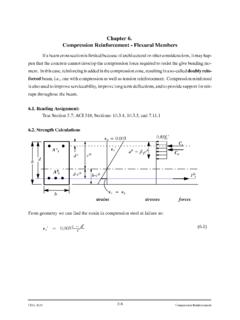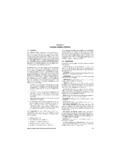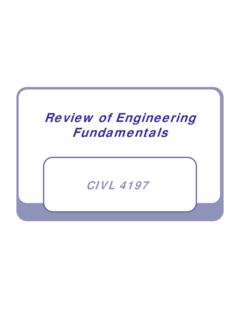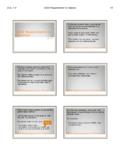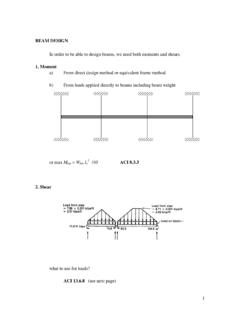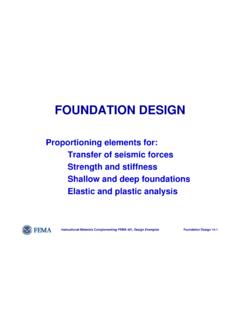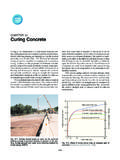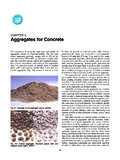Transcription of Chapter 2 – Introduction to the Stiffness (Displacement ...
1 Chapter 2 Introduction to the Stiffness (Displacement ) MethodLearning Objectives To define the Stiffness matrix To derive the Stiffness matrix for a spring element To demonstrate how to assemble Stiffness matrices intoa global Stiffness matrix To illustrate the concept of direct Stiffness method toobtain the global Stiffness matrix and solve a springassemblage problem To describe and apply the different kinds of boundaryconditions relevant for spring assemblages To show how the potential energy approach can be usedto both derive the Stiffness matrix for a spring and solvea spring assemblage problemThe Stiffness ( displacement ) MethodThis section introduces some of the basic concepts on which the direct Stiffness methodis based. The linear spring is simple and an instructive tool to illustrate the basic concepts.
2 The steps to develop a finite element model for a linear spring follow our general 8 step Discretize and Select Element Types- linear springelements2. Select a displacement Function -Assume a variationof the displacements over each Define the Strain/ displacement and Stress/StrainRelationships-use elementary concepts of equilibriumand 7/8117 Chapter 2 - The Stiffness Method1/32 The Stiffness ( displacement ) Method4. Derive the Element Stiffness Matrix and Equations-Define the Stiffness matrix for an element and then consider the derivation of the Stiffness matrix for a linear -elastic spring element. 5. Assemble the Element Equations to Obtain the Global or Total Equations and Introduce Boundary Conditions-We then show how the total Stiffness matrix for the problem can be obtained by superimposing the Stiffness matrices of the individual elements in a direct manner.
3 The term direct Stiffness methodevolved in reference to this method. The Stiffness ( displacement ) Method6. Solve for the Unknown Degrees of Freedom (or Generalized Displacements)-Solve for the nodal Solve for the Element Strains and Stresses-The reactions and internal forces association with the bar Interpret the ResultsCIVL 7/8117 Chapter 2 - The Stiffness Method2/32 The Stiffness ( displacement ) Method1. Select Element Type- Consider the linear spring shown below. The spring is of length Land is subjected to a nodal tensile force, Tdirected along the : Assumed sign conventionsThe Stiffness ( displacement ) Method2. Select a displacement Function- A displacement function u(x) is assumed. 12uaaxIn general, the number of coefficients in the displacement function is equal to the total number of degrees of freedom associated with the element.
4 We can write the displacement function in matrix forms as: 11x222x11auxa CIVL 7/8117 Chapter 2 - The Stiffness Method3/32 The Stiffness ( displacement ) MethodWe can express uas a function of the nodal displacements uiby evaluating uat each node and solving for a1and a2. 11(0)uxu a 22 1()ux L u aL aSolving fora2:212uuaL Substituting a1and a2into ugives: 211uuuxuL Boundary Conditions 121xxuuLLThe Stiffness ( displacement ) MethodIn matrix form:Or in another form: 121uxxuuLL 1122uuNNuWhere N1and N2are defined as:The functions Niare called interpolation functionsbecause they describe how the assumed displacement function varies over the domain of the element. In this case the interpolation functions are linear . 121xxNNLLCIVL 7/8117 Chapter 2 - The Stiffness Method4/32 The Stiffness ( displacement ) Method121uxxuuLL 1122uuNNu 2xNL 12uaax 11xNL 121 NNThe Stiffness ( displacement ) Method3.
5 Define the Strain/ displacement and Stress/Strain Relationships- Tensile forces produce a total elongation (deformation) of the spring. For linear springs, the force T and the displacementuare related by Hooke s law:Tk where deformation of the spring is given as: () (0)uL u21uu 1xf2xfTT 1xfT 2xfTCIVL 7/8117 Chapter 2 - The Stiffness Method5/32 The Stiffness ( displacement ) Method4. Step 4 - Derive the Element Stiffness Matrix and Equations -We can now derive the spring element Stiffness matrix as follows:Rewrite the forces in terms of the nodal displacements: 121xTfkuu 221xTf kuuWe can write the last two force- displacement relationships in matrix form as: 1122xxfukkfukk 112xfkuu 212xfkuuThe Stiffness ( displacement ) MethodThis formulation is valid as long as the spring deforms along the xaxis.
6 The coefficient matrix of the above equation is called the local Stiffness matrix k: kkkkk5. Step 4 - Assemble the Element Equations and Introduce Boundary ConditionsThe global Stiffness matrixand the global force vectorare assembled using the nodal force equilibrium equations, and force/deformation and compatibility equations. ()1 NeeKKk ()1 NeeFFfwhere kand fare the element Stiffness and force matrices expressed in global 7/8117 Chapter 2 - The Stiffness Method6/32 The Stiffness ( displacement ) Method6. Step 6 - Solve for the Nodal DisplacementsSolve the displacements by imposing the boundary conditions and solving the following set of equations: FKd7. Step 7 - Solve for the Element ForcesOnce the displacements are found, the forces in each element may be calculated from:Tk FKd 21ku uThe Stiffness Method Spring Example 1 Consider the following two-spring system shown below:where the element axis xcoincides with the global axis element 1:11113311xxfukkfukk For element 2:32232222xxfkkufkku CIVL 7/8117 Chapter 2 - The Stiffness Method7/32 The Stiffness Method Spring Example 1We can write the nodal equilibrium equation at each node as:Both continuity and compatibility require that both elements remain connected at node 3.
7 (1)(2)33uu (1)11xxFf (2)22xxFf (1)(2)33 3xx xFf f Element numberThe Stiffness Method Spring Example 1In matrix form the above equations are:Therefore the force- displacement equations for this spring system are:11113xFkuku 22322xFkuku 311132322xFkukukuku FKd1111222231212300xxxFkkuFkkuFkkkku where Fis the global nodal force vector, dis called the global nodal displacement vector, and Kis called the global Stiffness 1 Element 2 CIVL 7/8117 Chapter 2 - The Stiffness Method8/32 The Stiffness Method Spring Example 1 The elemental Stiffness matrices may be written for each the Total Stiffness Matrix by SuperpositionConsider the spring system defined in the last example:For element 1:For element 2: 13111(1)311uuukkukkk 32223(2)222uukkukkukThe Stiffness Method Spring Example 1 For element 2:Write the Stiffness matrix in global format for element 1 as follows:(1)11(1)122(1)3310 100010 1xxxufkufuf (1)11(1)222(1)3300 001 1011xxxufkufuf CIVL 7/8117 Chapter 2 - The Stiffness Method9/32 The Stiffness Method Spring Example 1 The above equations give:Apply the force equilibrium equations at each node.
8 1111222212123 300xxxkkuFkkuFkkkku F(1)11(2)22(1)(2)33 300xxxxxx xfFfFff F The Stiffness Method Spring Example 1To avoid the expansion of the each elemental Stiffness matrix, we can use a more direct, shortcut form of the Stiffness matrix. 32223(2)222uukkukkukThe global Stiffness matrix may be constructed by directly adding terms associated with the degrees of freedom in k(1)and k(2)into their corresponding locations in the Kas follows:12 31112221212300uu ukkukkukkkku K 13111(1)311uuukkukkkCIVL 7/8117 Chapter 2 - The Stiffness Method10/32 The Stiffness Method Spring Example 1 Boundary conditions are of two general types:1. homogeneous boundary conditions(the most common) occur at locations that are completely prevented from movement;2. nonhomogeneous boundaryconditions occur where finite non-zero values of displacement are specified, such as the settlement of a order to solve the equations defined by the global Stiffness matrix, we must apply some form of constraints or supports or the structure will be free to move as a rigid ConditionsThe Stiffness Method Spring Example 1 Consider the equations we developed for the two-spring system.
9 We will consider node 1 to be fixed u1= 0. The equations describing the elongation of the spring system become:111222212123 3000xxxkkFkkuFkkkku F Expanding the matrix equations gives:113xFku 22322xFkuku 322123xFkukku 23 Solve for anduu CIVL 7/8117 Chapter 2 - The Stiffness Method11/32 The Stiffness Method Spring Example 1 Once we have solved the above equations for the unknown nodal displacements, we can use the first equation in the original matrix to find the support second and third equation may be written in matrix form as:22223321 2xxuFkkuFkk k 113xFku For homogeneous boundary conditions, we can delete the row and column corresponding to the zero- displacement Stiffness Method Spring Example 1 Expanding the matrix equations gives:Let s again look at the equations we developed for the two-spring system.
10 However, this time we will consider a nonhomogeneous boundary condition at node 1: u1= . The equations describing the elongation of the spring system become:111222212123 300xxxkkFkkuFkkkku F 1113xFkku 22322xFkuku 31132322xF k ku ku ku CIVL 7/8117 Chapter 2 - The Stiffness Method12/32 The Stiffness Method Spring Example 1By considering the second and third equations because they have known nodal forces we get:22322xFkuku 31132322xF k ku ku ku In matrix form the above equations are:222233121 2xxuFkkuFkkk k For nonhomogeneous boundary conditions, we must transfer the terms from the Stiffness matrix to the right-hand-side force vector before solving for the unknown Stiffness Method Spring Example 1 Once we have solved the above equations for the unknown nodal displacements, we can use the first equation in the original matrix to find the support CIVL 7/8117 Chapter 2 - The Stiffness Method13/32 The Stiffness Method Spring Example 2 Consider the following three-spring system:The elemental Stiffness matrices for each element are: 1313(1)11100011k3434(2)11200011 k4242(3)11300011 kThe Stiffness Method Spring Example 2 Using the concept of superposition (the direct Stiffness method), the global Stiffness matrix is:The global force- displacement equations are.
